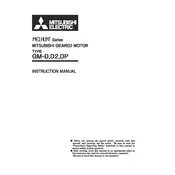Mitsubishi GMS-D Instruction Manual


Regular maintenance for the Mitsubishi GMS-D Motor should be conducted every 3,000 operational hours or at least once a year. This includes checking and replacing lubrication, inspecting electrical connections, and ensuring cooling systems are functioning properly.
Overheating can be caused by inadequate ventilation, overloading, or bearing failures. Ensure that the motor is not overloaded, verify that cooling fans are working, and inspect bearings for wear. If the problem persists, consult a professional technician.
To ensure proper alignment, use a dial indicator to measure shaft runout, check for soft foot conditions, and align the motor to the driven equipment using precision alignment tools. Recheck alignment after the motor is fully mounted.
To reset the motor after a fault, first disconnect the power supply. Investigate and rectify the cause of the fault, such as overload or overheating. After addressing the issue, reconnect the power and press the reset button located on the motor's control panel.
Common causes of vibration include misalignment, imbalance, and worn bearings. Solutions involve realigning the motor and load, rebalancing the rotor, and replacing worn bearings. Regular maintenance checks can prevent such issues.
Improving energy efficiency can be achieved by ensuring the motor is correctly sized for its application, maintaining proper alignment, using high-efficiency lubricants, and implementing variable frequency drives to optimize speed and load control.
The recommended lubrication for the bearings is a high-quality lithium-based grease. It is important to follow the manufacturer's guidelines on the quantity and frequency of lubrication to ensure optimal performance.
To replace the cooling fan, first disconnect the motor from the power supply. Remove the fan cover, then unbolt and detach the old fan. Install the new fan in the reverse order, ensuring it is securely fastened and balanced.
If the motor does not start, check the power supply and fuses, inspect the control circuit for faults, and ensure that the start switch is functioning. If these are in order, the issue may be with the motor windings or connections, requiring professional inspection.
The Mitsubishi GMS-D Motor is not designed for use in explosive environments. For such applications, motors specifically rated for hazardous areas, with appropriate explosion-proof certifications, should be used.